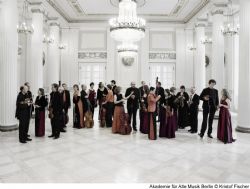|
Symphony
MONUMENTAL MAHLER 5TH IN SO CO PHIL'S SEASON ENDING CONCERT
by Terry McNeill
Sunday, April 14, 2024
Symphony
YOUTH ORCHESTRA CHARMS BIG SPRING LAKE AUDIENCE
by Terry McNeill
Wednesday, February 28, 2024
Symphony
SOLO BRILLIANCE IN SANTA ROSA SYMPHONY CONCERT
by Terry McNeill
Saturday, February 17, 2024
Symphony
HAYDEN'S SAXOPHONE CONCERTO AT SO CO PHIL CONCERT
by Ron Teplitz
Sunday, January 28, 2024
Symphony
SCHUBERT AND MENDELSSOHN BOUQUETS AT COLLEGE OF MARIN CONCERT
by Abby Wasserman
Saturday, December 9, 2023
Symphony
SYMPHONY'S MESSIAH ORATORIO A STUNNING HOLIDAY SUCCESS
by Pamela Hicks Gailey
Sunday, December 3, 2023
Symphony
TWO ORCHESTRAS AND FIVE DISPARATE WORKS IN WEILL HALL
by Ron Teplitz
Sunday, November 19, 2023
Symphony
MARIN SYMPHONY'S CHAMBER ENSEMBLE DAZZLES IN NEW SEASON CONCERT
by Abby Wasserman
Saturday, November 11, 2023
Symphony
TITANIC SRS MAHLER SYMPHONY IN WEILL NOV. 5
by Terry McNeill
Sunday, November 5, 2023
Symphony
PROFOUND SCHUMANN CONCERTO PERFORMANCE BY BRESHEARS AT THE JACKSON
by Terry McNeill
Sunday, October 29, 2023
|
 |
 Akademie fur Alte Musik Berlin |
FOREIGN AFFAIRS CHARACTERS OF THE BAROQUE
by Sonia Morse Tubridy
Sunday, March 12, 2017
Akademie für Alte Musik Berlin, known as Akamus, played a Weill Hall concert March 12 in a program called "Foreign Affairs -Characters of the Baroque.” The ensemble, that began in 1984, has 15 musicians led by concert master Bernhard Forck. Attired in elegant black with red accents, ranging from ties or shawls to socks and glass frames, the musicians, standing to play, engaged the audience immediately with sonic elegance, musical humor and clarity of purpose.
The opening piece was Telemann’s Overture Suite in B-flat, "Les Nations.” This suite set the stage for the theme of "foreign affairs." After a festive, then dance-like overture and two minuets played with exquisite sensibility, the music contained character pieces depicting "Turcs, Suisse, Muscovites, Portugais Anciens, Portugais modernes, the lame and the runners." Musical humor abounded with bold, rough and dramatic leaps for the Turks, then mournful moments alternating with lightness for the Swiss. The Muscovites were introduced with a silly and ominous bassoon bell sound alternating cleverly with cello and bass.
Then Portugal had the musicians smiling as they traded dotted rhythms and sudden accented motifs in the lower strings. Finally, the runners were fleet and the limping ones not. The audience found it all was entertaining and full of jolly sounds in good company.
Bach’s Brandenburg Concerto No. 4 in G major, BWV 1049, followed the Telemann.. This beloved piece, with three soloists, violin and two recorders (Anna Fusek and Xenia Loffler) juxtaposed with a larger string ensemble, soared in the Akamus performance and transcended traditional molds. The ensemble was clear and balanced. The musicians breathed and lived the rhythms and musical dialogues. The andante slow movement was heartbreaking in expressive power. Here, suspended dissonances and chromatic gestures filled the air and were moving and consoling. It is said that Baroque audiences in the Baroque era were moved to tears by the affective power of music and this concert was testimony to that. The presto movement followed "attacca" with dazzling fugal counterpoint, jazz-like riffs and the solo violin bow of Mr. Forck seemingly on fire. Bach's compositional magic swept onward and went into ever-widening realms of imagination and musical discoveries.
A happy crowd returned after intermission for Handel's Suite from Almira, HWV 1, his first opera.. This suite was comprised of instrumental sections written at the age of nineteen. and contains an international group of dances including a set called "The Masque of the Continents.” The playing of the overture had grandeur, as did the wandering of the chaconne and a fast courante with Ms. Fusek’s recorder solo. The sarabande was outstanding for its plaintive and hushed beauty, allowing the lute solo responses between string motifs. A fast and noisy bourree led to a courtly minuet with two oboes, a lively Rigaudon, a Rondeau with busy cello and bass lines, and a Ritornello. Many varieties of instruments were featured.
Vivaldi's Concerto for two oboes in d minor featured Baroque oboists Michael Bosche and Xenia Loffler. There were beautiful interactions between soloists and orchestra. The largo with the two oboes and continuo was highly expressive and the allegro conclusion had exciting fireworks following unison statements. Vivaldi's music is always fresh.
Jean Fery Rebel, French composer in the court of Louis XIV, continued the afternoon's focus on the variety of dance forms of Europe. His suite, "Les Characteres de la Dance,” was performed in a lighthearted and joyous manner. The fourteen dances were miniature treats linked together in a pastiche, some of the individual dances only eight measures long, with changes of meter and key defining the arrival of each next dance.
Loud applause and calls of bravo brought the orchestra back for a lively encore, “The Attack on the Windmill” from Telemann's seven-part “Don Quixote” Suite.
|
